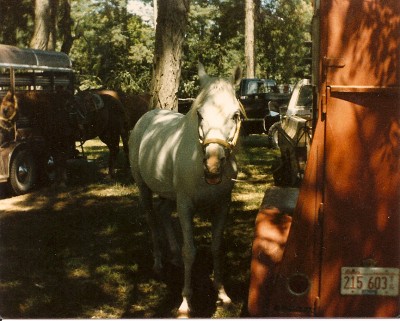Dakhala Sabiq, asil Ma’naqi Sbayli stallion in Illinois
A lady from Illinois recently sent me these snapshots of Wilbur Coates Ma’naqi Sbayli stallion Dakhala Sabiq (Prince Hal x Sirrulya by HJulyan), bred by Jeanne Craver. They were taken at a local show in Illinois. I now own Sabiq’s niece, Dakhala Sahra, by Plantagenet out of Soiree by Sir x Sirrulya.
I must say that this specific type of Arabian horse strikes a strong cord with me, because it’s reminiscent of the horses of my childhood, the ones I learned to ride on. The horse riding clubs around Beirut were full of former racehorses that hailed from Syria, had moderate or no success on the racetrack — which by then was dominated by the part-bred Arabs from Iraq. so the asils had no chance of winning — and ended their careers as children mounts.
Each club appeared to have its own old grey Arabian horse, a dream-like individual of regal type, worthy of Cindarella’s carriage that was the favorite of all the children. In East Beirut during the civil war (1975-1990), it was Sultan, on whom I learned to ride ( I will try to dig up a photo); in West Beirut after the war (1991-2000) it was Burhan, on whom I had my first jumping competitions; in Aleppo it was Mabruk. They were of perfect temperament and conformation, impossible to fault, and I had always wondered, without ever daring to ask my father, why these superior horses were not breeding stallions everybody rushed to breed from, and what they were doing in these god-forsaken riding clubs. The naive pre-teenager I was assumed that that they somehow deserved to be where they were, because they had defects I couldn’t see, or because their origins were unknown. I tried hard to identify these defects. Sometimes I would ask about their origins and the groom would give me their strains and previous owners. I didn’t know what to make of all this. It was only as I grew up that I realized that some horses are simply unlucky, and that people don’t always choose the best horse, or the purest, or the most authentic to become a stallion. Recently, I had a flashback of these thoughts when I saw the 25 year old stallion Medici (Florentine x HB Wadduda by Mariner) at Shirley Jacobsen’s in West Viriginia. He had spent all his career at the circus without ever having a foal, and I thought he worthy of being a well-used stallion.
The stallion Dakhala Sabiq in these amateur pictures reminds me a lot of these horses of my childhood. It’s that gentle look in the eyes (“come on, let me take you on a ride”), that dark skin around the eyes, that straight yet handsome profile, these long eyelashes and mobile eyes, large sockets, huge cheekbones, silky skin, straight legs, balanced conformation, tail set high in the air even when walking, upright carriage, and overall look of a “big small horse” that never tires, and patiently tolerates all your newbie mistakes.





Prince Hal, Pericles, Janan Abinoam, and Mariner were all such good-natured, beautiful white stallions who loved to take you on a ride–and each did take me on at least one ride when I was growing up. From photos and accounts, their ancestor Dhareb was another. Lucky for us, people had the good sense also to breed from them.
Thanks Edouard for sharing these photos and I agree with R.J. about the temperament of these horses. In addition to the good-natured qualities they also had vitality in the form of that exciting Arabian “presence” which catches the hearts of many. This combination of good temperament with the “joy to be alive” presence was so typical of Dakhala Sabiq. While your photos show a casual nature there is another photo of Dakhala Sabiq in an old Khamsat magazine [Khamsat Vol. 2, No. 1, page 20] that shows his brilliant movement and presence. This was a very memorable trait that many were able to enjoy who attended an Al Khamsa gathering in Illinois, some time in the 1980s I believe, when Dakhala Sabiq was presented there.
Exactly, Joe! I am sure there were other excellent horses presented that day, but Sabiq is the only one I remember. To me he was a vision of all the best qualities of the Arabian horse. As you say, Sabiq caught my heart.
and mine, too, even though I never saw him. I am now tracking down his nephew Bashiq (Plantagenet X Soiree by Sir).
Best of luck in finding Bashiq!
I think many of these stallions in North America were underused because they were of combined Al Khamsa source bloodlines and not straight this or that.
As you have also remarked, it is difficult to find a combined source stallion today.
I have Sabiq’s daughter-29 years old now and she is going through a second childhood with her pellet diet, very spunky! She looks much like her dad and should be around for years to come.